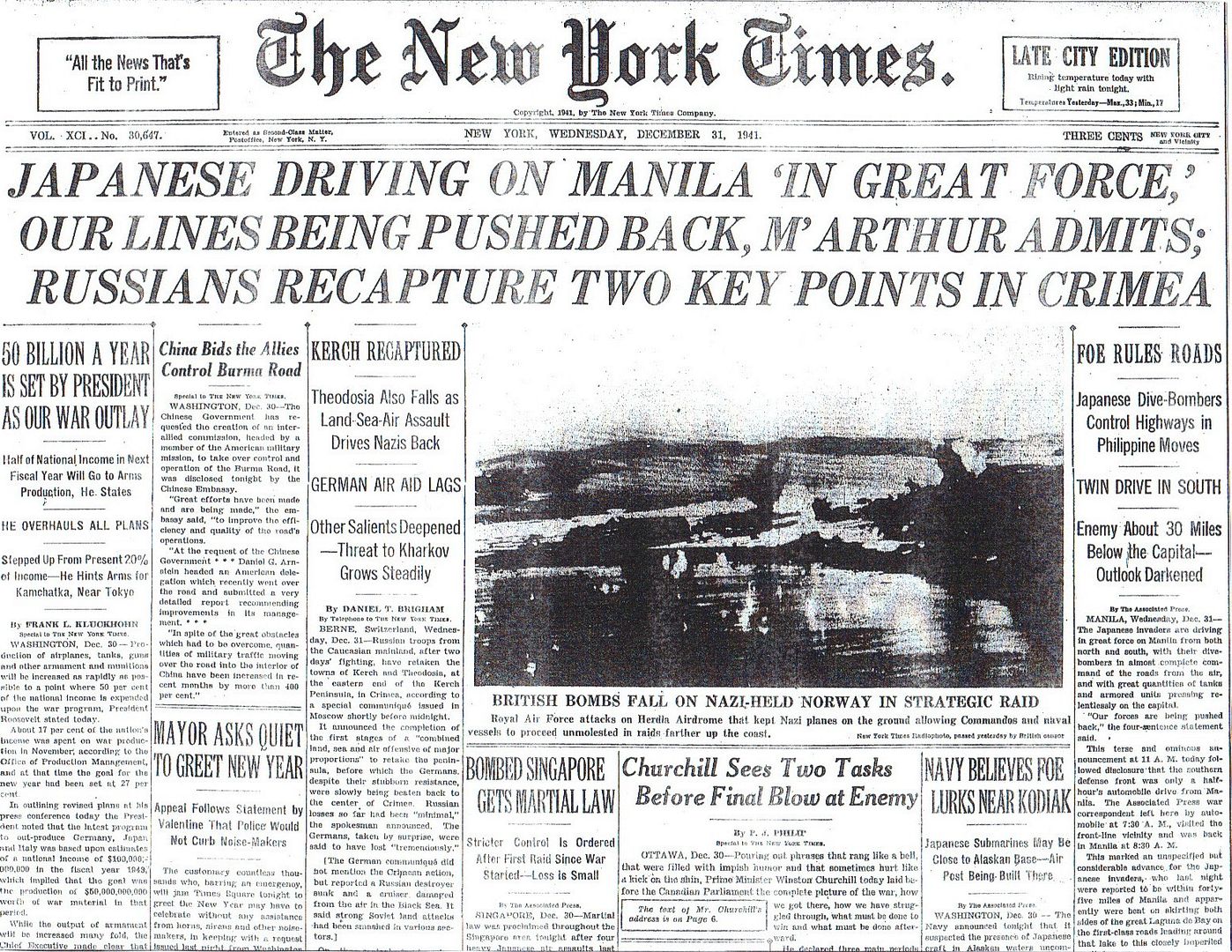
Posted on 12/31/2011 5:36:44 AM PST by Homer_J_Simpson

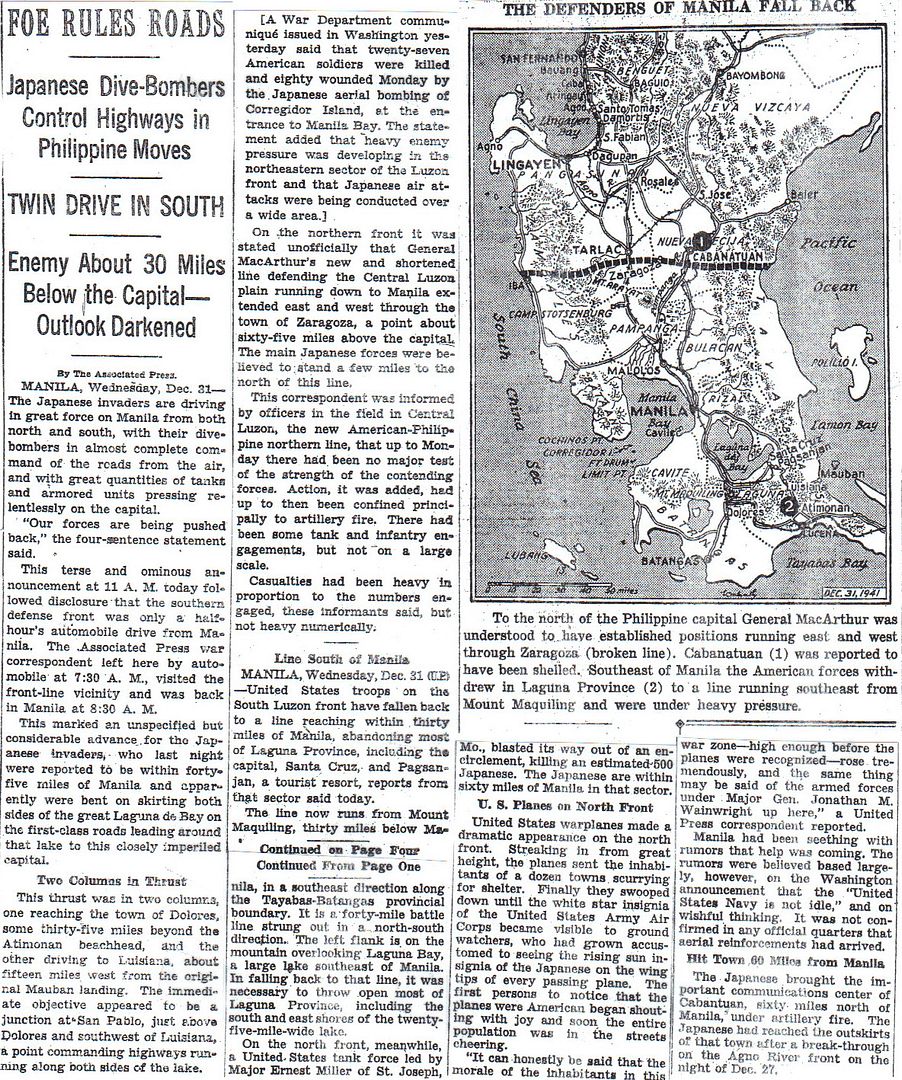
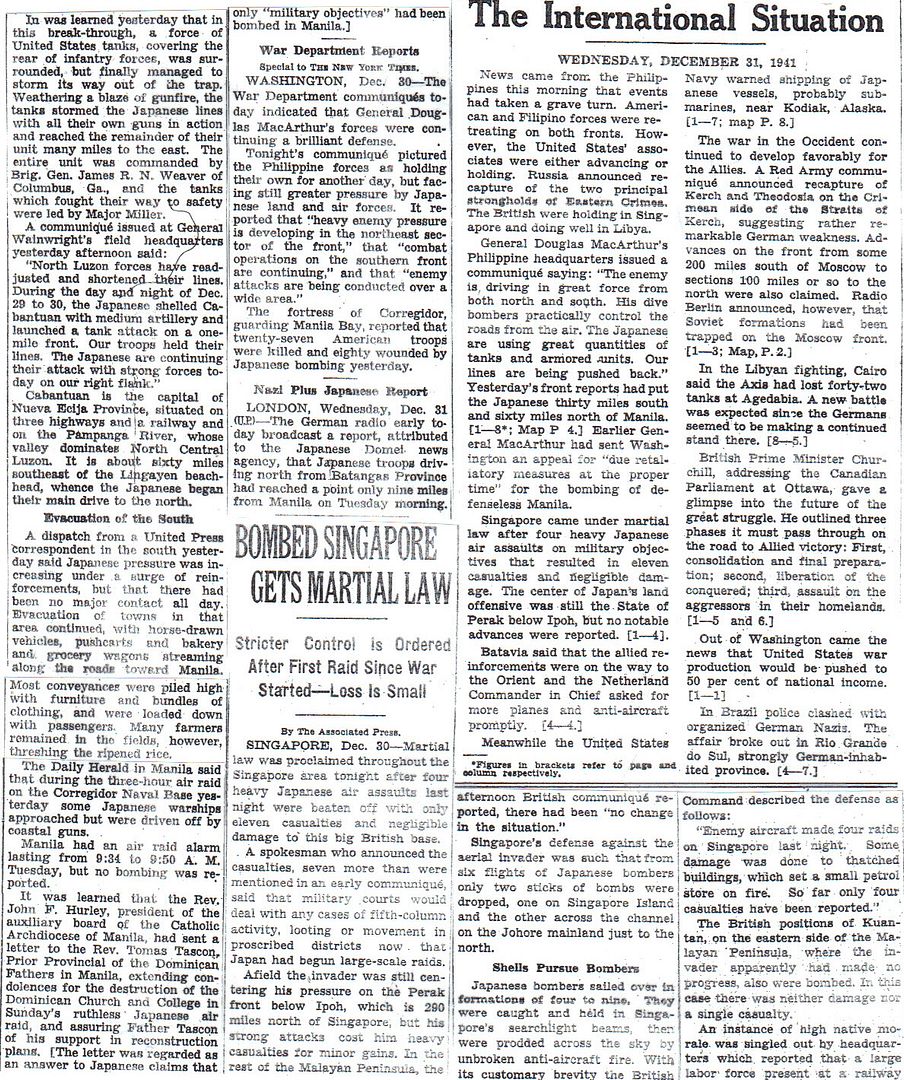
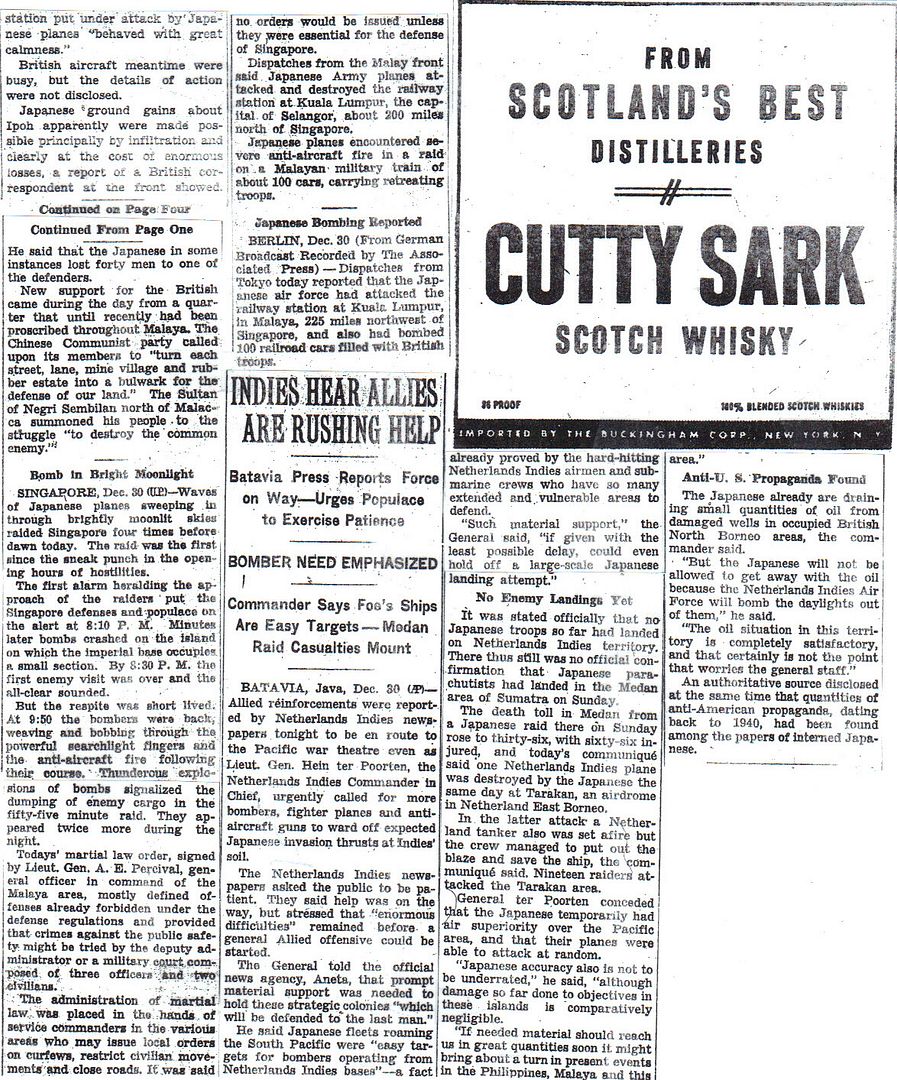
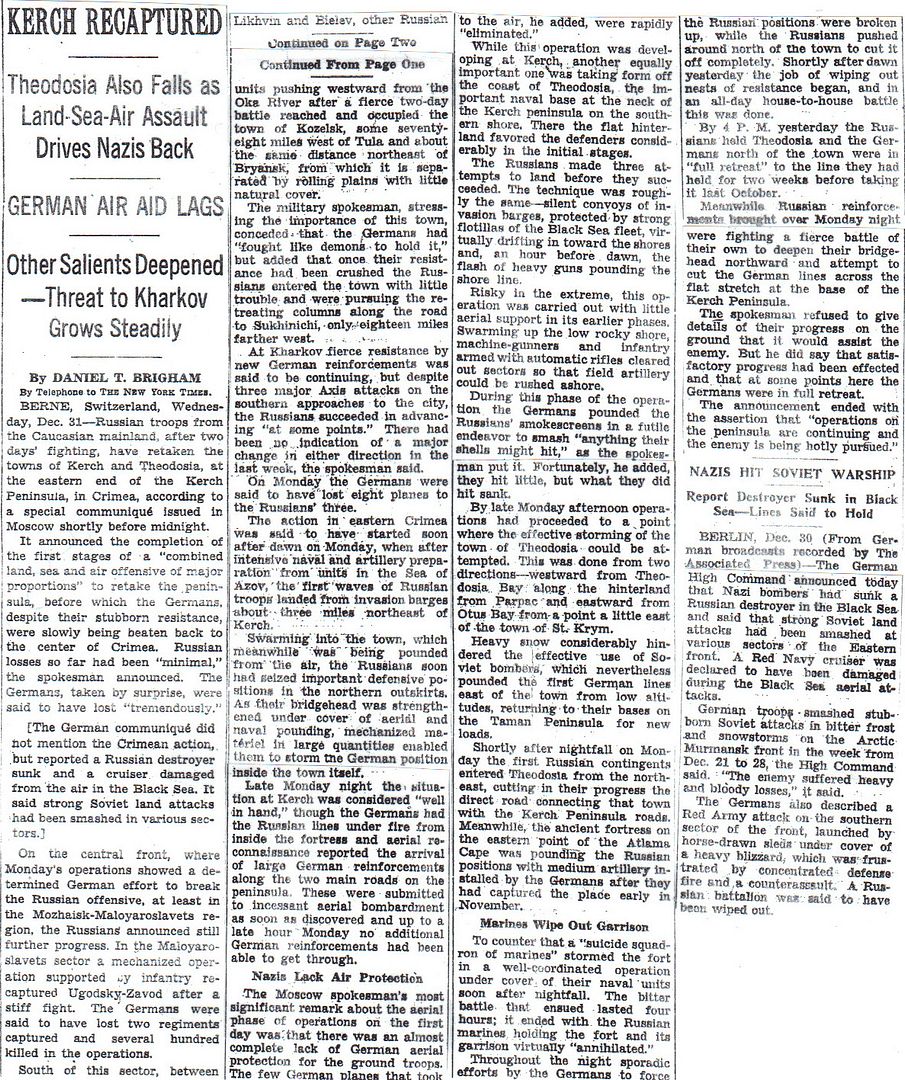

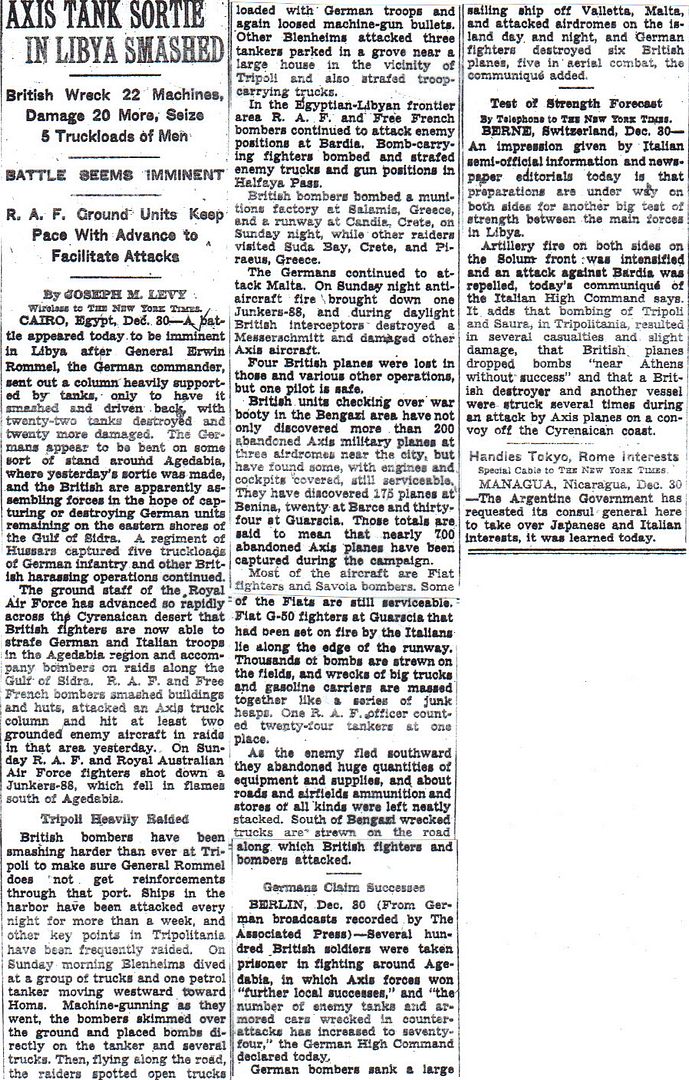
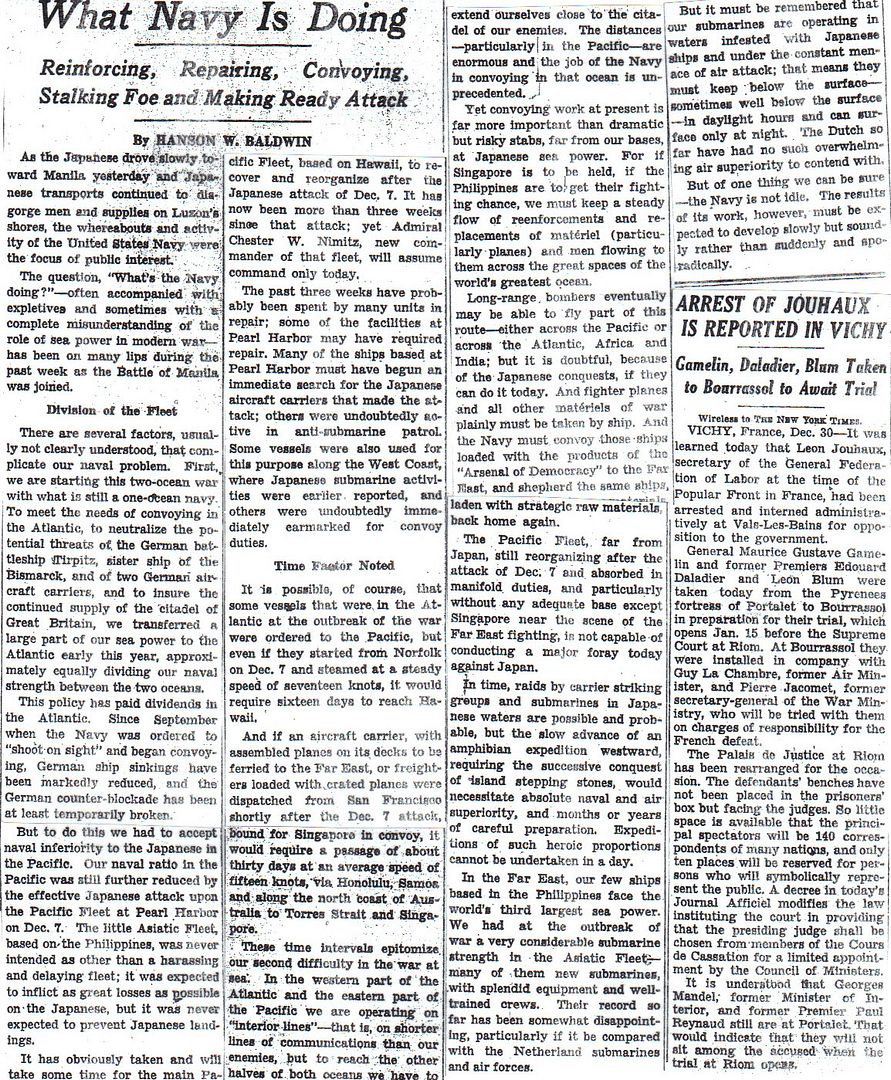
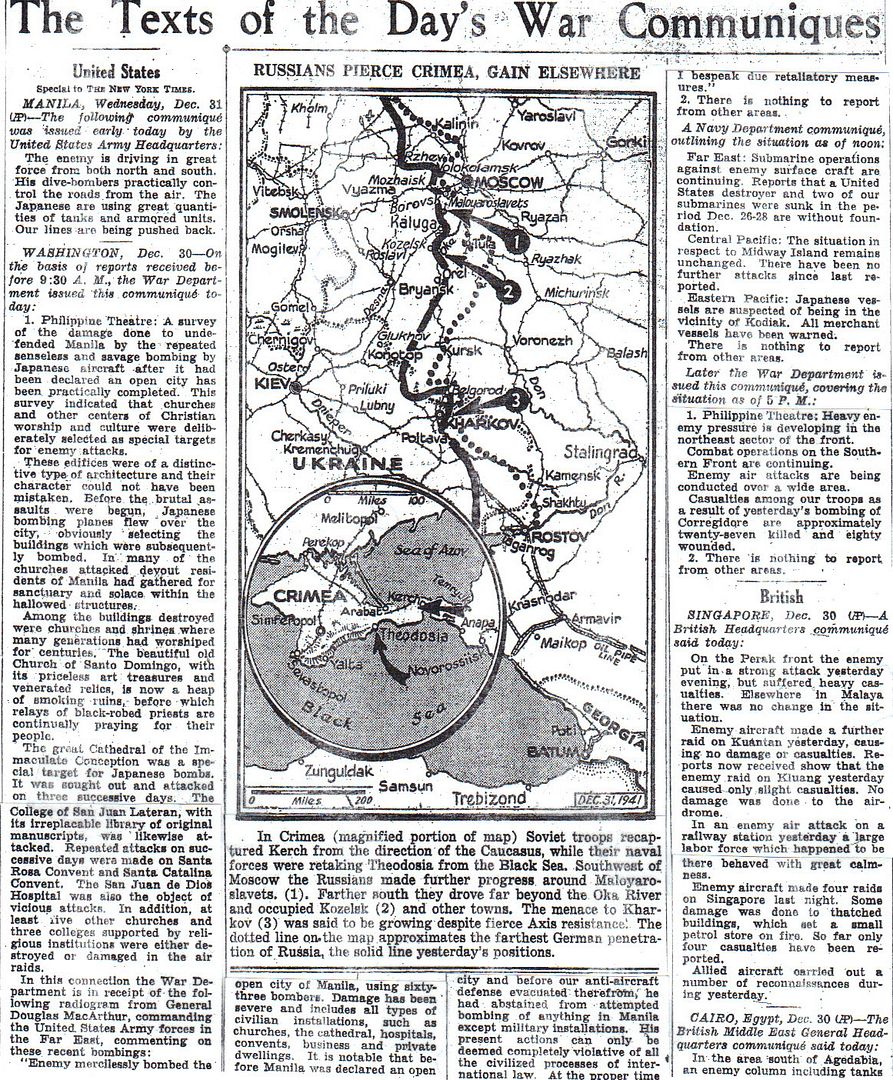
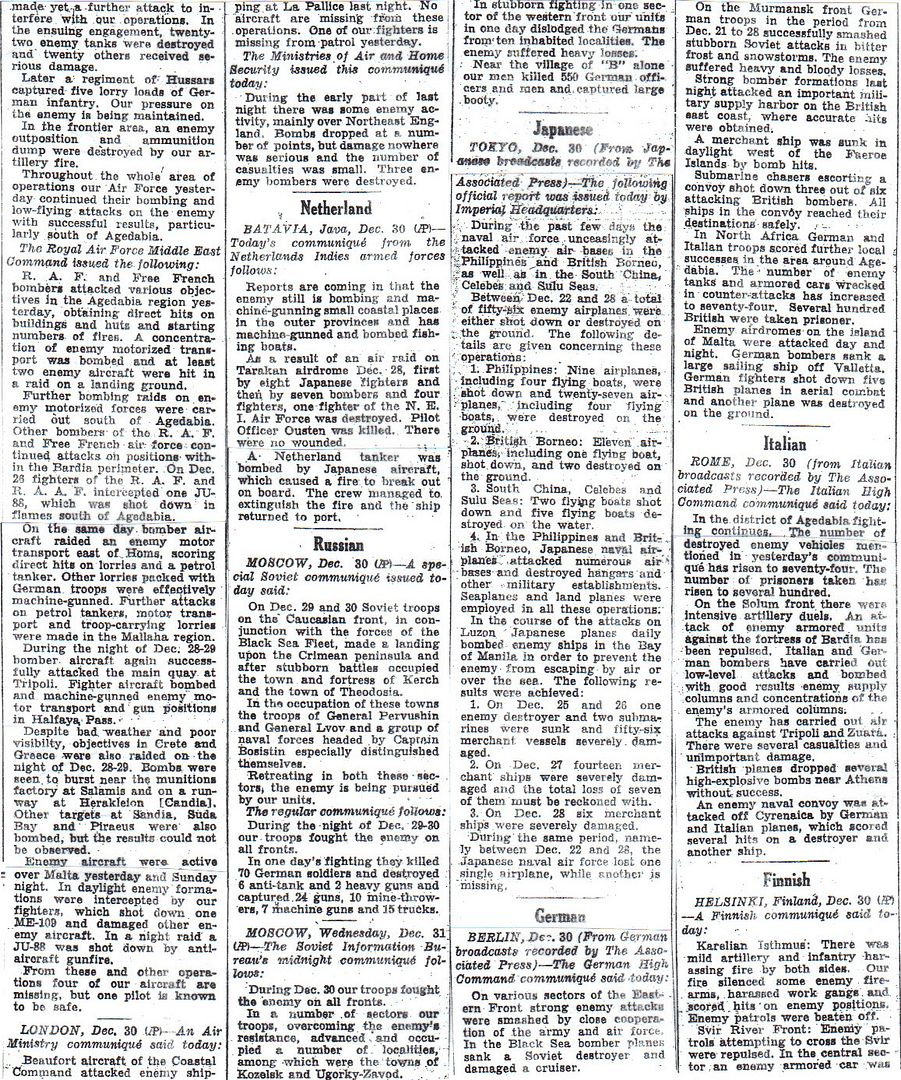
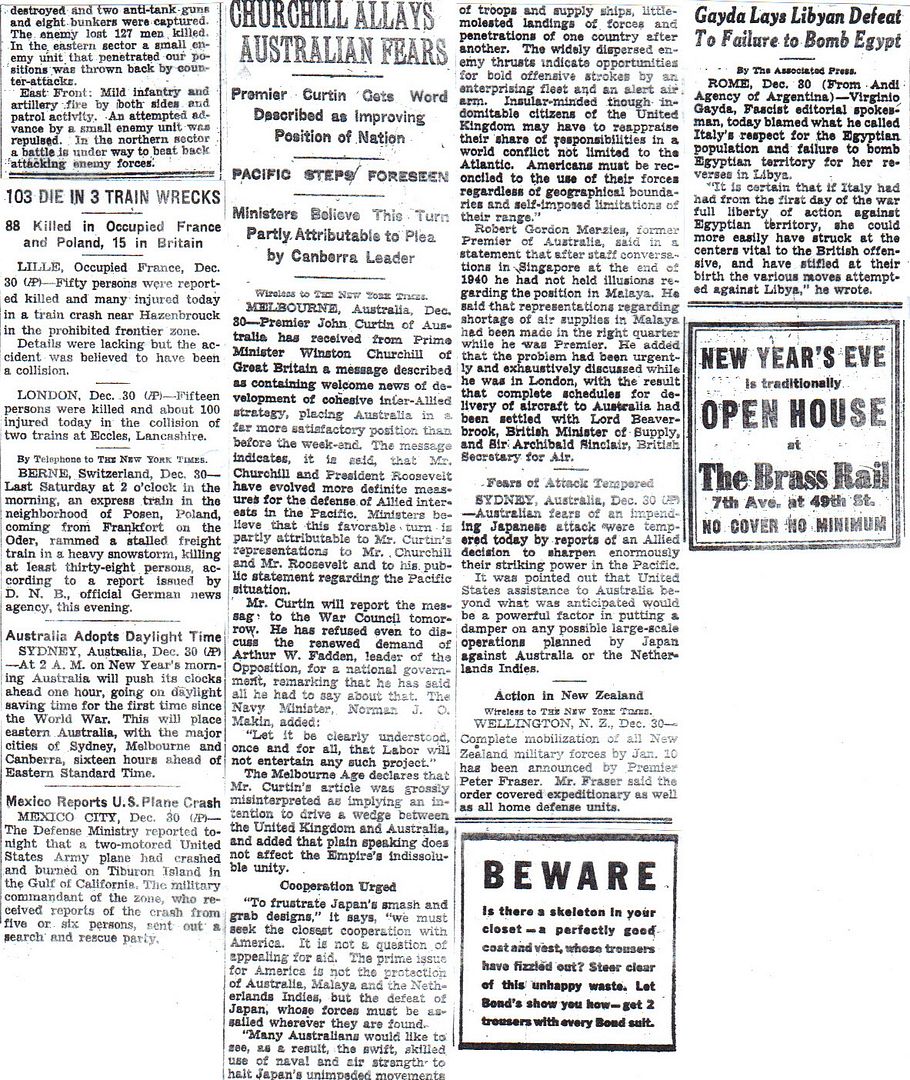
I’ll be drinking Cutty Sark at the Brass Rail tonight.
After which I’ll need the second pair of slacks with my Bond suit.
http://www.onwar.com/chrono/1941/dec41/f31dec41.htm
Philippines forces form new defense line
Wednesday, December 31, 1941 www.onwar.com
American defense line on the Bataan peninsulaIn the Philippines... American and Filipino forces form a new defense line north of the Bataan Peninsula, on Luzon.
On the Eastern Front... The Soviet winter offensive continues, though without a breakthrough. The Soviet armed forces have now suffered at least 5,000,000 casualties, 3,000,000 prisoners, 20,000 tanks and 30,000 guns destroyed. Even so they remain capable of resisting the German-led Axis invasion.
From the United States... General Brett takes command of US forces in Australia.
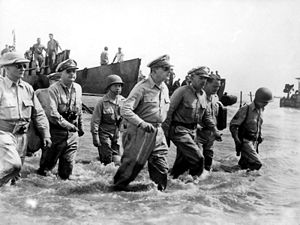
"I came through and I shall return"
After which I’ll need the second pair of slacks with my Bond suit.
It's good to know that our readers support our sponsors. Maybe I will raise the advertising rates for 1942. The war news is sure to sell a lot of papers so businesses shouldn't balk at a modest increase.
It is hard to put ones-self in the place of the citizen reading about these seemingly endless hammer blows by our enemies. This is just three and a half weeks after Pearl Harbor and there was nothing but bad news everywhere. The prepared Japanese appeared to be invincible as their short supply lines enabled them to have the advantage within the combat area. This was probably the blackest New Year since the American Revolution.
FYI: I see where our current President touched a commemorative wreath at the USS Arizona Memorial on Thursday.
I too “enjoy” reading old papers. It allows one to see and taste the ambience of the time.
If you have not done so...I highly recommend Herman Wouk’s materful WINDS OF WAR and WAR AND REMEMBERENCE; I believe Wouk is the closest we will get to an American Tolstoy.
These novels (the first one is better) put you in 1939-’45 America. Don’t miss them.
Yepper, read both and many more. I also consider the TV Miniseries of these (1983), starring Robert Mitchum, as being superior TV fare.
Now you've done it. Don't get me started!
I have been reading the novels in parallel with these threads. As familiar as I am with Wouk's books it is still amazing to see how he caught so many of the details at just the right times - something I didn't notice until this time around. Things like the Chicago Tribune publishing of the Rainbow plan and the apocryphal story from Wake Island - "Send more Japs." I came upon them just as we were discussing them here. Those are only two examples, but it has been happening right along.
I should report, though that just the other day I came across the first anachronisms I have noticed since the start of the novels. One of his characters, musing on the American public's apparent lack of seriousness about the war, refers to the ubiquitous sound of Bing Crosby singing White Christmas and Lucky Strike ads picturing Santa in a cutely tilted army helmet. I'm afraid Wouk is moving those images back from Christmas 1942. Just the same, he must have spent a lot of time reading old NYT issues while he was researching the books.
As for the TV miniseries', I like them too. At least when you get into War and Remembrance the cast improves in some respects. John Houseman and Ali McGraw are replaced. But we are still left with the decrepit Robert Mitchum and Polly Bergen playing characters 20 years younger than their actual ages.
Wow! I’m impressed you found the Bing Crosby error. Mostly Wouk is dead-on wonderful about bringing the sense of the time to his readers. I also enjoyed MARJORIE MORINGSTAR, and my personal favorite YOUNGBLOOD HAWK. Great, great books. Most of the junk being written today pales besides his great novels. Wouk has distilled the first half of the twentieth century into a few thousand pages.
I teach a high school Advanced Placement US History class, and every summer I force incoming students to read one of his books. Kids love CAIN MUTINY, but find MAJORIE MORINGSTAR kind of bizarre...it’s somewhat about a young girl protecting her virginity...or not. Not something teens can much identify with today.
I saw only bits and pieces of the tv series. Thought Ali McGraw was TERRIBLE. Never finished them.
I started watching Winds of War the other day on Netflix. Just something to help me settle in after working all night. Pretty good so far except I would live without Mitchum’s wife messing around with Peter Graves.
Goodbye 1941. Here’s hoping 1942 is a better year...
Wow, you mean that you actually teach something other than "Social Studies" and your curriculum allows you to teach about WW2? Shezam!
Sorry but there are times when modern schooling gets to me and to learn that you are one of the ones who dwell in the trenches means a lot. KUDOS to you and thanks!
"Fearful Jewish women and children huddle together in the cold and in fear on the beach at Liepaja, Latvia, where they await their deaths at the hands of Latvians and SS.
They are about to be stripped of their clothing and shot to death.
Jewish clothing is to be sent back to Germany to be used by German civilians.
(One report from a German soldier's wife indicates that she was angry that a few of the items of Jewish clothing sent back to her had bloodstains on them.)
At least 2,700 Jews were killed in this Aktion of December 1941."
'Yabut' (military for Yeah, but), at least at that age, they had a memory for the time to lend 'muscle memory' to their acting. While Mitchum (1917-97) was not in the military (medical 4F I think), he did work in the LA area as a machinist while learning acting. Bergen (b:1930) was a child but still probably had a better appreciation of those years than would a more suitably age-matched actress in the 1982-3 filming time.
http://homepage.ntlworld.com/andrew.etherington/frame.htm
December 31st, 1941
UNITED KINGDOM: Frigate HMCS (ex-HMS) Ettrick laid down Sunderland.
Destroyer HMS Milne launched. (Dave Shirlaw)
GERMANY: Berlin: Despite its setback outside the gates of Moscow, the territory controlled by the Third Reich is far greater than it was a year ago. Overall the war still appears to be going well for Germany, but how is the Nazi war economy standing up?
For the first year of the war the Third Reich - well prepared for war - suffered few real changes in the life style of its people. The country has had to double its arms production. Britain on the other hand, faced a sixfold increase, and American arms production has soared by a factor of more than eight. In the early days of the war, Germany was able to draw on adequate supplies. Rapid victories in Poland and France used less material than had been planned for. It was the Battle of Britain, followed by the Russian invasion, that began to cause gaps.
The sinking of the Bismarck and other naval losses brought about the mobilization of resources for extra shipbuilding, with workers, factories and raw materials being diverted from civilian goods production.
Germany has become increasingly dependent on imported or confiscated raw materials. In Poland, France and occupied Russia, everything that might be of value is taken. At the beginning of the year, the Nazi regime concluded a trade deal for 9,000 tons of non-ferrous metal with the Soviet Union. Most had been delivered before the invasion.
An officer was washed overboard from U-701, the last casualty of the year. [Leutnant zur See Bernhard Weinitschke].
U-487 laid down. (Dave Shirlaw)
ARCTIC SEA: During heavy weather a lookout on U-584 broke his arm. (Dave Shirlaw)
U.S.S.R.: Losses for the Red Army total at least 5 million casualties, 3 million prisoners, 20,000 tanks and 30,000 guns. Despite these losses the Soviets will retain initiative on the front well into spring.
Leningrad: The city is still holding out after four months of siege, but its people are suffering terribly from hunger and cold. It is commonplace to see a sledge with the swaddled body of a child being dragged to a cemetery by the child’s mother. Sometimes she falls down dead beside her infant, exhausted by the effort.
It is estimated that some 3,000 people are dying every day from starvation despite the suicide runs of lorry convoys across the frozen ice of Lake Ladoga. These lorries running by night along a marked track, come under fire from the German guns and almost every night one of them slips through the ice to be swallowed up.
There is no fuel for buses and no electric heating for houses. Ancient wood-burning stoves have been recovered from the scrap heap. Many people keep warm only by burning their furniture. The people are also suffering from the diseases of malnutrition.
Scurvy is prevalent. The thick overcoats of the women who queue for bread which often never arrives hide bellies swollen by hunger.
Flour is mixed with sawdust. The strong brave the long dangerous trek to the frozen fields where they dig for potatoes. And as the long agony of Leningrad goes on there are rumours of cannibalism.
BORNEO: The last British troops retreat into the Dutch East Indies.
COMMONWEALTH OF THE PHILIPPINES: A composite US force attacks the Japanese 7th Tank Regiment (part of 48th Division) near Plaridel. The Japanese tanks are massing for an attack on 51st Division (Philippines Army) when Maj-Gen Jones, orders a spoiling attack by two platoons of Company C, 192nd Tank Battalion, covered a six 75mm SPMs. The US tanks rolled into Baliuag village and engage in a close range fight which knocks out 8 Japanese tanks without loss to the Americans.
The Official History (207) says that the SPMs didn’t fire until after the US tanks had withdrawn for fear of hitting their own. Therefore it would seem likely that an M3 Light Tank claimed the first tank vs tank kill.
Earlier in the day the Japanese tanks had come under US Field Artillery and tank fire at Plaridel. (Michael Alexander)(207)
AUSTRALIA: General Brett takes command of US forces here.
Major General George H. Brett was appointed Chief of the Air Corps in May 1941 and then was ordered to Australia to take command of U.S. Forces in Australia, redesignated U.S. Army Forces in Australia (USAFIA) on 5 January 1942.
He returned to the US and was designated Commanding General Caribeean defence Command and the U.S. Army’s Panama Canal Department in November 1942. (Jack McKillop)
Canberra: “This is the gravest hour of our history,” declared prime minister John Curtin, on 8 December after Pearl Harbor.
Nothing has prepared this country for the disasters to come. For two years Australia has been fighting a war mainly in overseas theatres as part of the British war effort. But now Australians see themselves in a direct struggle for survival - with combat taking place on or near Australian territory. After the initial shock, the mood here was confident. It was not conceivable that the mighty United States, could be defeated in the war by Japan.
But the debacle at Pearl Harbor, the destruction of the American Far East air forces in the Philippines and the Japanese landings in Malaya and Thailand, together with the sinking of the Prince of Wales and the Repulse have alarmed the Australian people and their government to a marked degree.
After two weeks of war in South-east Asia, the situation is grave. Major-General Gordon Bennett, the Australian army commander in Malaya, has asked for at least one Australian division to be transferred from the Middle East. The Australian government has sent a message to Churchill and Roosevelt, meeting in Washington, asking for Singapore to be reinforced. The loss of the base would mean the isolation of this continent.
CANADA: Corvette HMCS Bittersweet arrived Charleston SC for refit. (Dave Shirlaw)
U.S.A.: Washington: Churchill’s visit will be rounded off with a review of the Anglo-American military staff talks - known as the Arcadian conference - which have been taking place during the past week. One outcome of the talks has been the decision, stubbornly opposed by some on the American side, to identify Hitler’s Germany as the main threat to the Allies.
The immediate danger is presented by the Japanese conquest of the East Indies, with their vast stores of strategic raw materials. When Japan has been put on the defensive, a full-scale invasion of Europe will be mounted for the decisive battle with Germany.
Soon after Churchill’s arrival in Washington, just before Christmas, agreement was reached on the creation of a joint war council and joint supply council. These two bodies will attempt to match the demands of the military planners to the availability of guns, tanks, aircraft and other war materials.
The Dow-Jones Industrial Average finished the year at 110.96 -15.38%
down on the year.
The War Production Board notes that since 1 July 1940 208,000 trucks have been delivered to the military, of which nearly 84,000 are under 1¼ tons. (Will O’Neil)
Submarine USS Gato commissioned.
Destroyer USS Bancroft launched. (Dave Shirlaw)
VENEZUELA: Diplomatic relations with Germany, Italy and Japan are severed. (Jack McKillop)
ATLANTIC OCEAN: At 1954, the Cardita, a straggler from convoy HX-166, was torpedoed by U-87 110 miles 307° from St. Kilda. The vessel foundered in 59°42N/11°58W on 3 January. 27 crewmembers were lost. The master, 16 crewmembers and six gunners were picked up by destroyer HMS Onslow and ten crewmembers by HMS Sabre and landed at Reykjavik. (Dave Shirlaw)
Disclaimer: Opinions posted on Free Republic are those of the individual posters and do not necessarily represent the opinion of Free Republic or its management. All materials posted herein are protected by copyright law and the exemption for fair use of copyrighted works.